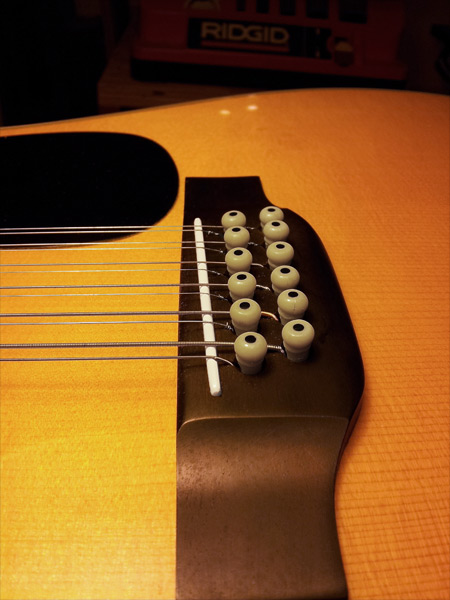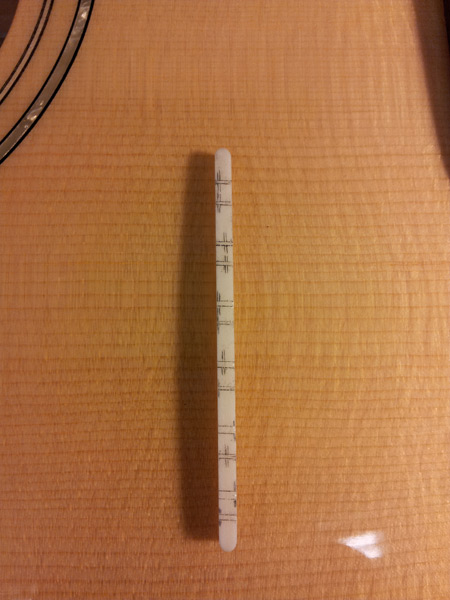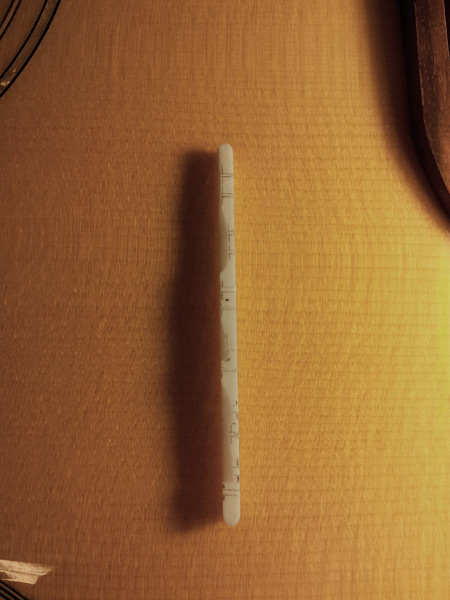360.261.0341
5321 NE 30th Ave., Vancouver, WA 98663
By Appointment Only

Rick Reiss, Luthier
Authorized Warranty Service for C. F. Martin Guitar Co. and Taylor Guitars
This first picture is from a Martin D-12-28 with its original saddle. Notice the top of the saddle is simply half-round, like a fret. This original saddle is made from Micarta, a lightweight synthetic material that Martin Guitars used for years and years. It is not a very good sounding material when compared to bone.
This is the completed, handmade, replacement bone saddle.
Three key observations here:
1. As the string passes over the saddle from the bridgepin, the amount of string contact to the saddle changes, depending on the string size and note it's tuned to. This is called an intonated saddle, which plays in tune dramatically better than the original "fret shaped" saddle. Envisioning an electric guitar with six individual adjustable saddles can be a helpful perspective.
2. Perhaps a less noticeable observation is that the strings angle across the upgraded saddle is less obtuse. That's because this is a guitar on which I've also removed the neck and reset the its angle, for an ideal saddle height. If a saddle is too short like the original, than there is insufficient torque, to leverage the vibrating surface area of the top. If a saddle is too tall, then the structural integrity of the guitar will be compromised and things will start to fall apart.
3. Bone is the best sounding material one can use for the nut and/or saddle on a guitar. There is a near endless variety of materials one can use. For example: Micarta, Graphtech/Tusq, Corian, ivory, mammoth ivory, horn, ebony, Mother of pearl, etc. Whew! By the way, I think a new crappy plastic is spawned like maybe once a week, from only God knows where... sighs.
This is a view of the top of an unshaped 12 string saddle, with the appropriate markings for proper intonation and each strings scale length.
In this perspective, I've only carved the front side of the saddle, to show some additional contrast, before carving the back side. After shaping the curves on the back side for the different break angles of the two rows of bridge pin holes, the last step is to sand and polish everything out.
A general summary: If you upgrade the material, replace the nut and/or saddle on your guitar, you can expect a minimum increase of approximately 20% in the volume of your acoustic guitar. Factory saddles (even factory bone saddles) are pre-shaped and are often fit loosely or even shimmed. Most factory saddles are a bit of a "knife edge". A shim or piezo pickup under the saddle of your guitar can reduce the output of your guitars projection by 15% or more. Nuts are rarely fit well to the shelf at the end of the fingerboard. The material, fit, and string contact all cooperatively contribute to the efficiency and character of tone. I often analogize the before and after difference to be akin to viewing a black and white television versus a high definition television. I have personal instruments in my shop that are representative of these upgrades. I use them to serve as an example of how comfortably (after all of the fine tuning of these adjustments are performed) and enjoyable a guitar should be to play and hear.






